Epidemiology Report: Assessing IPTi Study Design and Outcomes
VerifiedAdded on 2021/01/14
|10
|3244
|155
Report
AI Summary
This report examines an epidemiological study focusing on the impact of Intermittent Preventive Treatment in infants (IPTi) on malaria and anemia. The study employed an intervention design, evaluating IPTi's effectiveness through both intention-to-treat and per-protocol analyses. The report details the study's methodology, including participant allocation, data collection methods (household and health facility surveys), and the selection of study areas in Tanzania. The analysis explores the association between IPTi and the reduction of malaria parasitemia and anemia prevalence, highlighting the different outcomes observed through the two analytical methods. The results indicate the effectiveness of IPTi in reducing both malaria and anemia, with specific data provided on the prevalence rates before and after the intervention. Furthermore, the report discusses the benefits and limitations of the study design and the analytical approaches used, offering insights into the appropriate measures of association and the interpretation of the results. The conclusion summarizes the findings and underscores the public health implications of the intervention.

Basic Epidemiology
Paraphrase This Document
Need a fresh take? Get an instant paraphrase of this document with our AI Paraphraser

Table of Contents
INTRODUCTION...........................................................................................................................3
TASK...............................................................................................................................................3
Type of epidemiological study used...........................................................................................3
Determine association being investigated, exposure and two main outcomes of interest that
were measured.............................................................................................................................4
Process used to allocate individuals to IPTi or no- IPTi recognising different levels of
selection.......................................................................................................................................4
Methods used to select people for data collection to analyse the paper......................................5
Evaluation of exposed and unexposed things.............................................................................5
Results of 'intention to treat' and 'per protocol'...........................................................................6
Appropriate measure of association............................................................................................7
Different results shown by the given two methods.....................................................................7
Study design and methods of evaluation with benefits and limitations......................................8
CONCLUSION................................................................................................................................9
REFERENCES..............................................................................................................................10
INTRODUCTION...........................................................................................................................3
TASK...............................................................................................................................................3
Type of epidemiological study used...........................................................................................3
Determine association being investigated, exposure and two main outcomes of interest that
were measured.............................................................................................................................4
Process used to allocate individuals to IPTi or no- IPTi recognising different levels of
selection.......................................................................................................................................4
Methods used to select people for data collection to analyse the paper......................................5
Evaluation of exposed and unexposed things.............................................................................5
Results of 'intention to treat' and 'per protocol'...........................................................................6
Appropriate measure of association............................................................................................7
Different results shown by the given two methods.....................................................................7
Study design and methods of evaluation with benefits and limitations......................................8
CONCLUSION................................................................................................................................9
REFERENCES..............................................................................................................................10
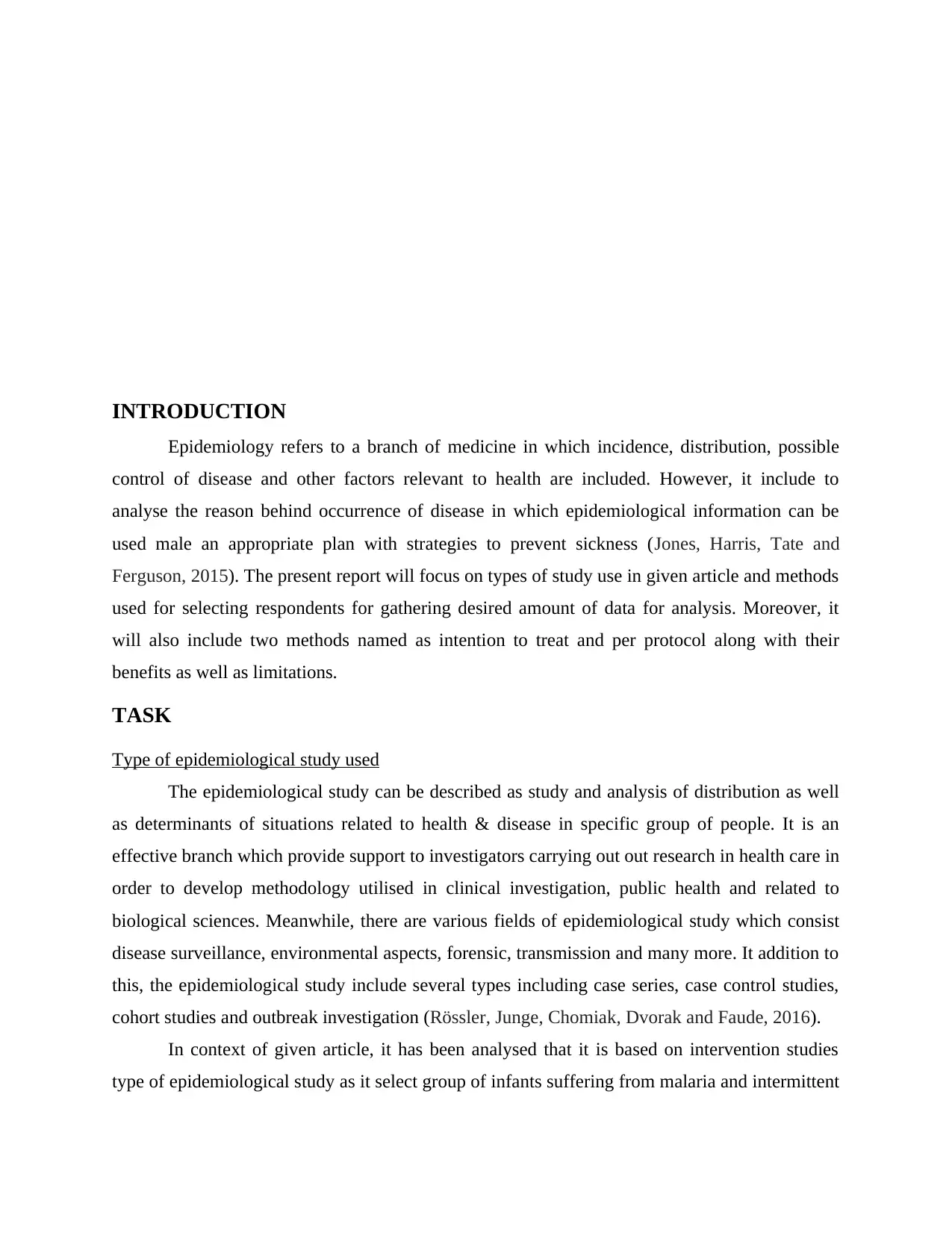
INTRODUCTION
Epidemiology refers to a branch of medicine in which incidence, distribution, possible
control of disease and other factors relevant to health are included. However, it include to
analyse the reason behind occurrence of disease in which epidemiological information can be
used male an appropriate plan with strategies to prevent sickness (Jones, Harris, Tate and
Ferguson, 2015). The present report will focus on types of study use in given article and methods
used for selecting respondents for gathering desired amount of data for analysis. Moreover, it
will also include two methods named as intention to treat and per protocol along with their
benefits as well as limitations.
TASK
Type of epidemiological study used
The epidemiological study can be described as study and analysis of distribution as well
as determinants of situations related to health & disease in specific group of people. It is an
effective branch which provide support to investigators carrying out out research in health care in
order to develop methodology utilised in clinical investigation, public health and related to
biological sciences. Meanwhile, there are various fields of epidemiological study which consist
disease surveillance, environmental aspects, forensic, transmission and many more. It addition to
this, the epidemiological study include several types including case series, case control studies,
cohort studies and outbreak investigation (Rössler, Junge, Chomiak, Dvorak and Faude, 2016).
In context of given article, it has been analysed that it is based on intervention studies
type of epidemiological study as it select group of infants suffering from malaria and intermittent
Epidemiology refers to a branch of medicine in which incidence, distribution, possible
control of disease and other factors relevant to health are included. However, it include to
analyse the reason behind occurrence of disease in which epidemiological information can be
used male an appropriate plan with strategies to prevent sickness (Jones, Harris, Tate and
Ferguson, 2015). The present report will focus on types of study use in given article and methods
used for selecting respondents for gathering desired amount of data for analysis. Moreover, it
will also include two methods named as intention to treat and per protocol along with their
benefits as well as limitations.
TASK
Type of epidemiological study used
The epidemiological study can be described as study and analysis of distribution as well
as determinants of situations related to health & disease in specific group of people. It is an
effective branch which provide support to investigators carrying out out research in health care in
order to develop methodology utilised in clinical investigation, public health and related to
biological sciences. Meanwhile, there are various fields of epidemiological study which consist
disease surveillance, environmental aspects, forensic, transmission and many more. It addition to
this, the epidemiological study include several types including case series, case control studies,
cohort studies and outbreak investigation (Rössler, Junge, Chomiak, Dvorak and Faude, 2016).
In context of given article, it has been analysed that it is based on intervention studies
type of epidemiological study as it select group of infants suffering from malaria and intermittent
⊘ This is a preview!⊘
Do you want full access?
Subscribe today to unlock all pages.

Trusted by 1+ million students worldwide
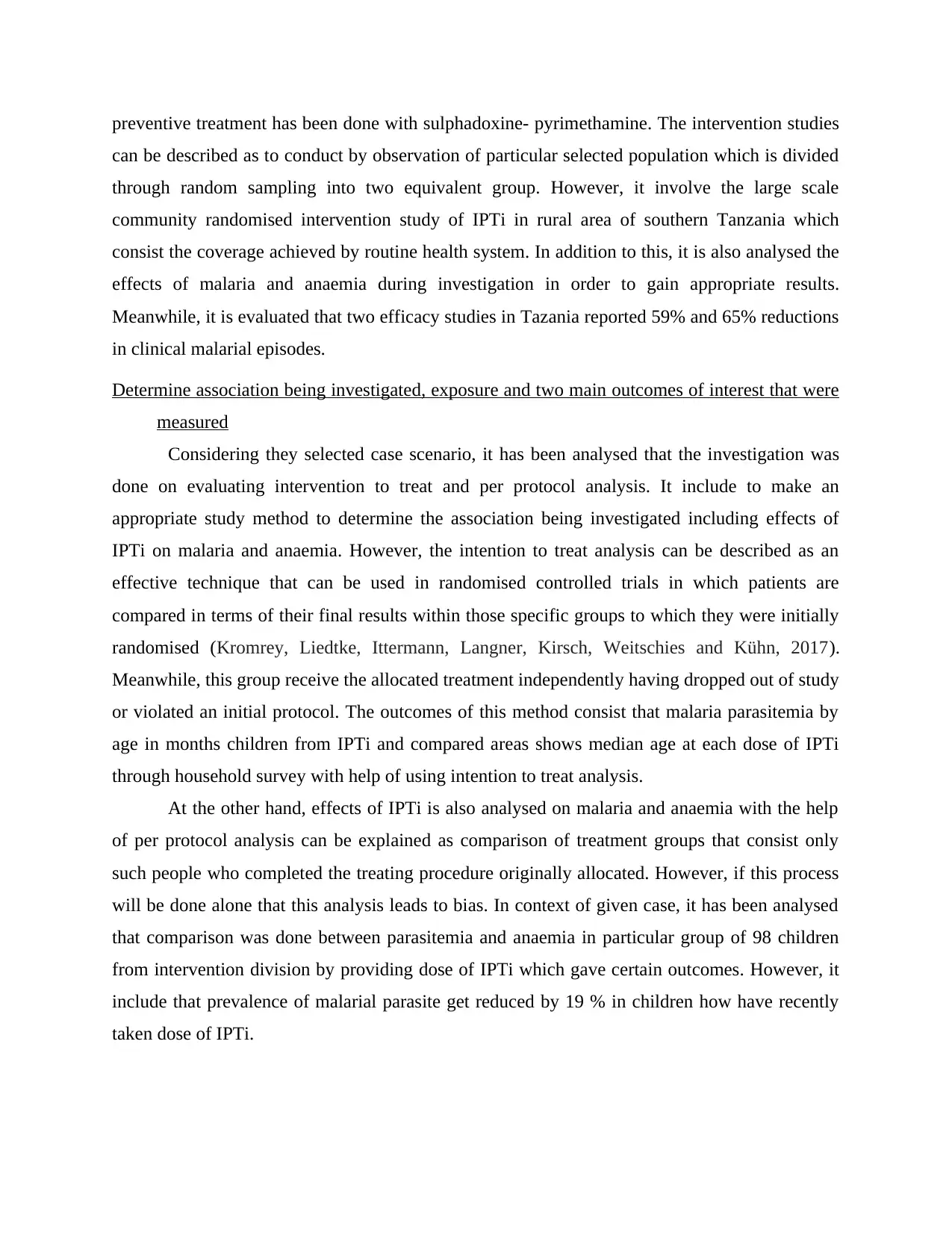
preventive treatment has been done with sulphadoxine- pyrimethamine. The intervention studies
can be described as to conduct by observation of particular selected population which is divided
through random sampling into two equivalent group. However, it involve the large scale
community randomised intervention study of IPTi in rural area of southern Tanzania which
consist the coverage achieved by routine health system. In addition to this, it is also analysed the
effects of malaria and anaemia during investigation in order to gain appropriate results.
Meanwhile, it is evaluated that two efficacy studies in Tazania reported 59% and 65% reductions
in clinical malarial episodes.
Determine association being investigated, exposure and two main outcomes of interest that were
measured
Considering they selected case scenario, it has been analysed that the investigation was
done on evaluating intervention to treat and per protocol analysis. It include to make an
appropriate study method to determine the association being investigated including effects of
IPTi on malaria and anaemia. However, the intention to treat analysis can be described as an
effective technique that can be used in randomised controlled trials in which patients are
compared in terms of their final results within those specific groups to which they were initially
randomised (Kromrey, Liedtke, Ittermann, Langner, Kirsch, Weitschies and Kühn, 2017).
Meanwhile, this group receive the allocated treatment independently having dropped out of study
or violated an initial protocol. The outcomes of this method consist that malaria parasitemia by
age in months children from IPTi and compared areas shows median age at each dose of IPTi
through household survey with help of using intention to treat analysis.
At the other hand, effects of IPTi is also analysed on malaria and anaemia with the help
of per protocol analysis can be explained as comparison of treatment groups that consist only
such people who completed the treating procedure originally allocated. However, if this process
will be done alone that this analysis leads to bias. In context of given case, it has been analysed
that comparison was done between parasitemia and anaemia in particular group of 98 children
from intervention division by providing dose of IPTi which gave certain outcomes. However, it
include that prevalence of malarial parasite get reduced by 19 % in children how have recently
taken dose of IPTi.
can be described as to conduct by observation of particular selected population which is divided
through random sampling into two equivalent group. However, it involve the large scale
community randomised intervention study of IPTi in rural area of southern Tanzania which
consist the coverage achieved by routine health system. In addition to this, it is also analysed the
effects of malaria and anaemia during investigation in order to gain appropriate results.
Meanwhile, it is evaluated that two efficacy studies in Tazania reported 59% and 65% reductions
in clinical malarial episodes.
Determine association being investigated, exposure and two main outcomes of interest that were
measured
Considering they selected case scenario, it has been analysed that the investigation was
done on evaluating intervention to treat and per protocol analysis. It include to make an
appropriate study method to determine the association being investigated including effects of
IPTi on malaria and anaemia. However, the intention to treat analysis can be described as an
effective technique that can be used in randomised controlled trials in which patients are
compared in terms of their final results within those specific groups to which they were initially
randomised (Kromrey, Liedtke, Ittermann, Langner, Kirsch, Weitschies and Kühn, 2017).
Meanwhile, this group receive the allocated treatment independently having dropped out of study
or violated an initial protocol. The outcomes of this method consist that malaria parasitemia by
age in months children from IPTi and compared areas shows median age at each dose of IPTi
through household survey with help of using intention to treat analysis.
At the other hand, effects of IPTi is also analysed on malaria and anaemia with the help
of per protocol analysis can be explained as comparison of treatment groups that consist only
such people who completed the treating procedure originally allocated. However, if this process
will be done alone that this analysis leads to bias. In context of given case, it has been analysed
that comparison was done between parasitemia and anaemia in particular group of 98 children
from intervention division by providing dose of IPTi which gave certain outcomes. However, it
include that prevalence of malarial parasite get reduced by 19 % in children how have recently
taken dose of IPTi.
Paraphrase This Document
Need a fresh take? Get an instant paraphrase of this document with our AI Paraphraser
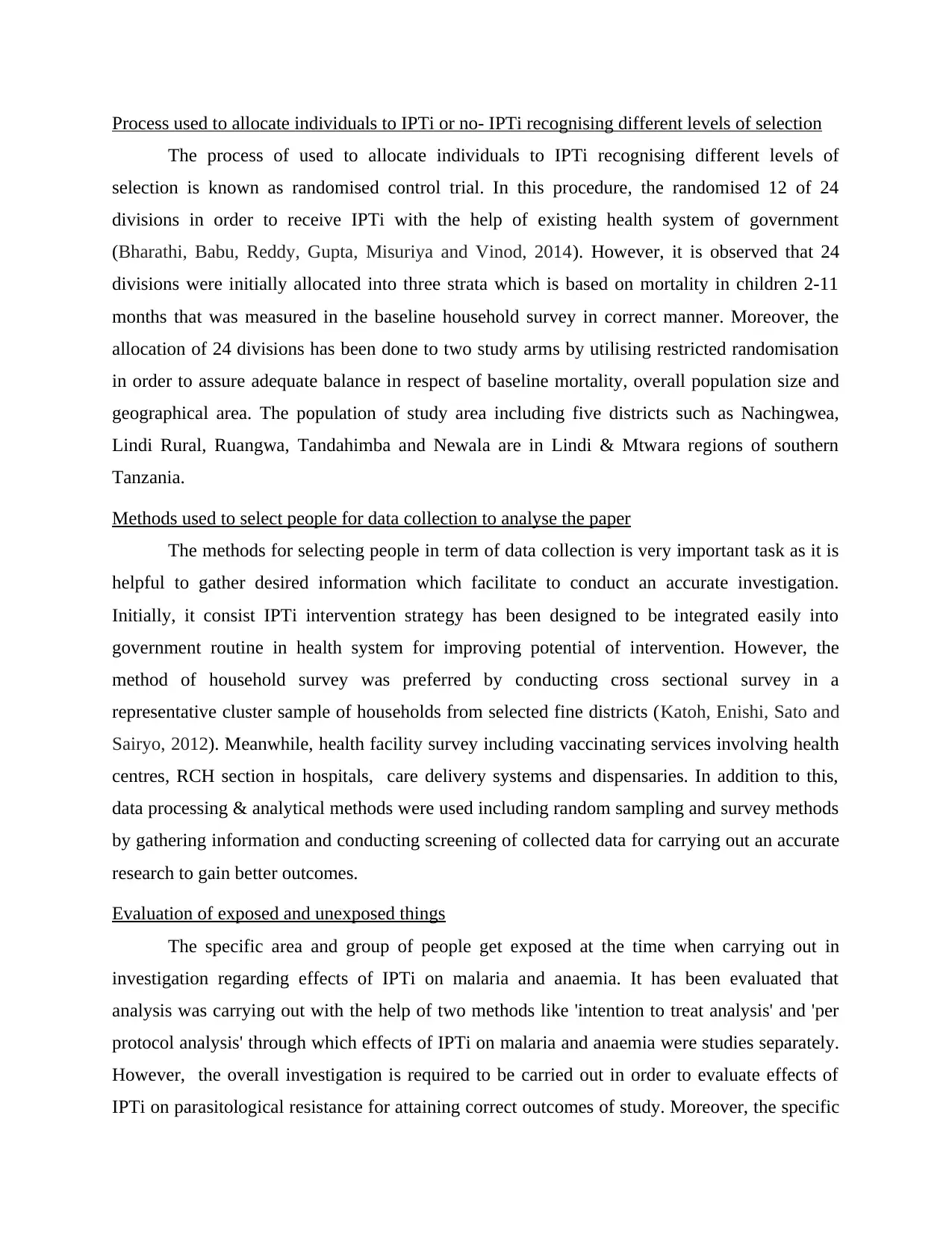
Process used to allocate individuals to IPTi or no- IPTi recognising different levels of selection
The process of used to allocate individuals to IPTi recognising different levels of
selection is known as randomised control trial. In this procedure, the randomised 12 of 24
divisions in order to receive IPTi with the help of existing health system of government
(Bharathi, Babu, Reddy, Gupta, Misuriya and Vinod, 2014). However, it is observed that 24
divisions were initially allocated into three strata which is based on mortality in children 2-11
months that was measured in the baseline household survey in correct manner. Moreover, the
allocation of 24 divisions has been done to two study arms by utilising restricted randomisation
in order to assure adequate balance in respect of baseline mortality, overall population size and
geographical area. The population of study area including five districts such as Nachingwea,
Lindi Rural, Ruangwa, Tandahimba and Newala are in Lindi & Mtwara regions of southern
Tanzania.
Methods used to select people for data collection to analyse the paper
The methods for selecting people in term of data collection is very important task as it is
helpful to gather desired information which facilitate to conduct an accurate investigation.
Initially, it consist IPTi intervention strategy has been designed to be integrated easily into
government routine in health system for improving potential of intervention. However, the
method of household survey was preferred by conducting cross sectional survey in a
representative cluster sample of households from selected fine districts (Katoh, Enishi, Sato and
Sairyo, 2012). Meanwhile, health facility survey including vaccinating services involving health
centres, RCH section in hospitals, care delivery systems and dispensaries. In addition to this,
data processing & analytical methods were used including random sampling and survey methods
by gathering information and conducting screening of collected data for carrying out an accurate
research to gain better outcomes.
Evaluation of exposed and unexposed things
The specific area and group of people get exposed at the time when carrying out in
investigation regarding effects of IPTi on malaria and anaemia. It has been evaluated that
analysis was carrying out with the help of two methods like 'intention to treat analysis' and 'per
protocol analysis' through which effects of IPTi on malaria and anaemia were studies separately.
However, the overall investigation is required to be carried out in order to evaluate effects of
IPTi on parasitological resistance for attaining correct outcomes of study. Moreover, the specific
The process of used to allocate individuals to IPTi recognising different levels of
selection is known as randomised control trial. In this procedure, the randomised 12 of 24
divisions in order to receive IPTi with the help of existing health system of government
(Bharathi, Babu, Reddy, Gupta, Misuriya and Vinod, 2014). However, it is observed that 24
divisions were initially allocated into three strata which is based on mortality in children 2-11
months that was measured in the baseline household survey in correct manner. Moreover, the
allocation of 24 divisions has been done to two study arms by utilising restricted randomisation
in order to assure adequate balance in respect of baseline mortality, overall population size and
geographical area. The population of study area including five districts such as Nachingwea,
Lindi Rural, Ruangwa, Tandahimba and Newala are in Lindi & Mtwara regions of southern
Tanzania.
Methods used to select people for data collection to analyse the paper
The methods for selecting people in term of data collection is very important task as it is
helpful to gather desired information which facilitate to conduct an accurate investigation.
Initially, it consist IPTi intervention strategy has been designed to be integrated easily into
government routine in health system for improving potential of intervention. However, the
method of household survey was preferred by conducting cross sectional survey in a
representative cluster sample of households from selected fine districts (Katoh, Enishi, Sato and
Sairyo, 2012). Meanwhile, health facility survey including vaccinating services involving health
centres, RCH section in hospitals, care delivery systems and dispensaries. In addition to this,
data processing & analytical methods were used including random sampling and survey methods
by gathering information and conducting screening of collected data for carrying out an accurate
research to gain better outcomes.
Evaluation of exposed and unexposed things
The specific area and group of people get exposed at the time when carrying out in
investigation regarding effects of IPTi on malaria and anaemia. It has been evaluated that
analysis was carrying out with the help of two methods like 'intention to treat analysis' and 'per
protocol analysis' through which effects of IPTi on malaria and anaemia were studies separately.
However, the overall investigation is required to be carried out in order to evaluate effects of
IPTi on parasitological resistance for attaining correct outcomes of study. Moreover, the specific

group of people are selected from particular areas to determine impact of using IPTi in respect of
malaria and anaemia (Meurs, Roest, Wolffenbuttel, Stolk, Jonge and Rosmalen, 2016). There are
several aspects which has been exposed in selected investigation including children as sample
with age of 2 to 11 months old in specific five districts like Nachingwea, Lindi Rural, Ruangwa,
Tandahimba and Newala are in Lindi & Mtwara regions of southern Tanzania.
Additionally, the study was undertaken within framework of assessment of community
defectiveness of IPTi and received ethical approval from local & national institutional review
boards. It include household survey and prefer to data collection from health centres, RCH
section in hospitals, care delivery systems and dispensaries in order to carrying out health facility
survey in proper manner to gain desired results. At the other hand, several aspects remain
unexposed including adult and old people because they may also get suffer from the dangerous
disease i.e. malaria and anaemia. Moreover, rest of places were unexposed as the investigation
has been done in few of certain districts then it is necessary to conduct research of these skipped
places because people living in other geographical areas also get infected with health issue of
malaria and anaemia.
Results of 'intention to treat' and 'per protocol'
Considering information gathered by given article, it has been evaluated the surveys were
conducted including household and health facility survey in terms of achieving appropriate
findings. It include to study the impact of IPTi on malaria and anaemia with the help of 'intention
to treat' analysis and 'per protocol' analysis. However, measurement of both of these analysis is
explained further –
Effects of IPTi on malaria: Intention to treat analysis
The method of intention to treat analysis refers to make comparison of treatment groups
which consist overall sick people as originally allocated after randomisation. It has been
determined that the test of Plasmodium falciparum results about 621 children of age 2 to 11
months that prevalence of parasitemia has dropped from 58 % in the year around 2004 to 34 % in
2006. In addition to this, with the help of using an effective method of Intention to treat analysis
an evidence was gained that IPTi resulted in less malaria by determining certain findings (Tao,
Shi and Zhao, 2015). It was founded that parasitemia was identified in 31 % of kids in those
areas where IPTi is available but at the other hand this ratio is 38 % of children living in
malaria and anaemia (Meurs, Roest, Wolffenbuttel, Stolk, Jonge and Rosmalen, 2016). There are
several aspects which has been exposed in selected investigation including children as sample
with age of 2 to 11 months old in specific five districts like Nachingwea, Lindi Rural, Ruangwa,
Tandahimba and Newala are in Lindi & Mtwara regions of southern Tanzania.
Additionally, the study was undertaken within framework of assessment of community
defectiveness of IPTi and received ethical approval from local & national institutional review
boards. It include household survey and prefer to data collection from health centres, RCH
section in hospitals, care delivery systems and dispensaries in order to carrying out health facility
survey in proper manner to gain desired results. At the other hand, several aspects remain
unexposed including adult and old people because they may also get suffer from the dangerous
disease i.e. malaria and anaemia. Moreover, rest of places were unexposed as the investigation
has been done in few of certain districts then it is necessary to conduct research of these skipped
places because people living in other geographical areas also get infected with health issue of
malaria and anaemia.
Results of 'intention to treat' and 'per protocol'
Considering information gathered by given article, it has been evaluated the surveys were
conducted including household and health facility survey in terms of achieving appropriate
findings. It include to study the impact of IPTi on malaria and anaemia with the help of 'intention
to treat' analysis and 'per protocol' analysis. However, measurement of both of these analysis is
explained further –
Effects of IPTi on malaria: Intention to treat analysis
The method of intention to treat analysis refers to make comparison of treatment groups
which consist overall sick people as originally allocated after randomisation. It has been
determined that the test of Plasmodium falciparum results about 621 children of age 2 to 11
months that prevalence of parasitemia has dropped from 58 % in the year around 2004 to 34 % in
2006. In addition to this, with the help of using an effective method of Intention to treat analysis
an evidence was gained that IPTi resulted in less malaria by determining certain findings (Tao,
Shi and Zhao, 2015). It was founded that parasitemia was identified in 31 % of kids in those
areas where IPTi is available but at the other hand this ratio is 38 % of children living in
⊘ This is a preview!⊘
Do you want full access?
Subscribe today to unlock all pages.

Trusted by 1+ million students worldwide
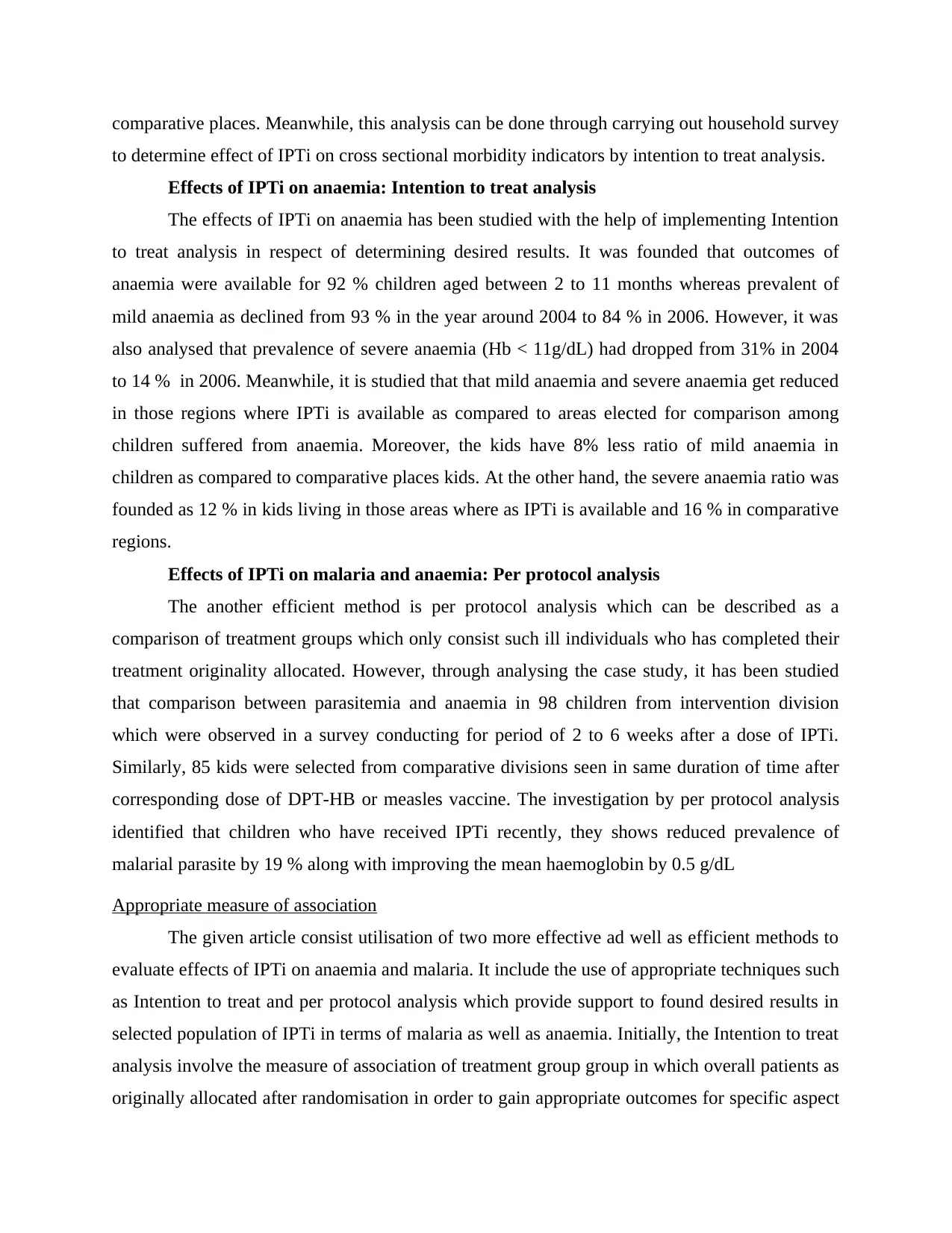
comparative places. Meanwhile, this analysis can be done through carrying out household survey
to determine effect of IPTi on cross sectional morbidity indicators by intention to treat analysis.
Effects of IPTi on anaemia: Intention to treat analysis
The effects of IPTi on anaemia has been studied with the help of implementing Intention
to treat analysis in respect of determining desired results. It was founded that outcomes of
anaemia were available for 92 % children aged between 2 to 11 months whereas prevalent of
mild anaemia as declined from 93 % in the year around 2004 to 84 % in 2006. However, it was
also analysed that prevalence of severe anaemia (Hb < 11g/dL) had dropped from 31% in 2004
to 14 % in 2006. Meanwhile, it is studied that that mild anaemia and severe anaemia get reduced
in those regions where IPTi is available as compared to areas elected for comparison among
children suffered from anaemia. Moreover, the kids have 8% less ratio of mild anaemia in
children as compared to comparative places kids. At the other hand, the severe anaemia ratio was
founded as 12 % in kids living in those areas where as IPTi is available and 16 % in comparative
regions.
Effects of IPTi on malaria and anaemia: Per protocol analysis
The another efficient method is per protocol analysis which can be described as a
comparison of treatment groups which only consist such ill individuals who has completed their
treatment originality allocated. However, through analysing the case study, it has been studied
that comparison between parasitemia and anaemia in 98 children from intervention division
which were observed in a survey conducting for period of 2 to 6 weeks after a dose of IPTi.
Similarly, 85 kids were selected from comparative divisions seen in same duration of time after
corresponding dose of DPT-HB or measles vaccine. The investigation by per protocol analysis
identified that children who have received IPTi recently, they shows reduced prevalence of
malarial parasite by 19 % along with improving the mean haemoglobin by 0.5 g/dL
Appropriate measure of association
The given article consist utilisation of two more effective ad well as efficient methods to
evaluate effects of IPTi on anaemia and malaria. It include the use of appropriate techniques such
as Intention to treat and per protocol analysis which provide support to found desired results in
selected population of IPTi in terms of malaria as well as anaemia. Initially, the Intention to treat
analysis involve the measure of association of treatment group group in which overall patients as
originally allocated after randomisation in order to gain appropriate outcomes for specific aspect
to determine effect of IPTi on cross sectional morbidity indicators by intention to treat analysis.
Effects of IPTi on anaemia: Intention to treat analysis
The effects of IPTi on anaemia has been studied with the help of implementing Intention
to treat analysis in respect of determining desired results. It was founded that outcomes of
anaemia were available for 92 % children aged between 2 to 11 months whereas prevalent of
mild anaemia as declined from 93 % in the year around 2004 to 84 % in 2006. However, it was
also analysed that prevalence of severe anaemia (Hb < 11g/dL) had dropped from 31% in 2004
to 14 % in 2006. Meanwhile, it is studied that that mild anaemia and severe anaemia get reduced
in those regions where IPTi is available as compared to areas elected for comparison among
children suffered from anaemia. Moreover, the kids have 8% less ratio of mild anaemia in
children as compared to comparative places kids. At the other hand, the severe anaemia ratio was
founded as 12 % in kids living in those areas where as IPTi is available and 16 % in comparative
regions.
Effects of IPTi on malaria and anaemia: Per protocol analysis
The another efficient method is per protocol analysis which can be described as a
comparison of treatment groups which only consist such ill individuals who has completed their
treatment originality allocated. However, through analysing the case study, it has been studied
that comparison between parasitemia and anaemia in 98 children from intervention division
which were observed in a survey conducting for period of 2 to 6 weeks after a dose of IPTi.
Similarly, 85 kids were selected from comparative divisions seen in same duration of time after
corresponding dose of DPT-HB or measles vaccine. The investigation by per protocol analysis
identified that children who have received IPTi recently, they shows reduced prevalence of
malarial parasite by 19 % along with improving the mean haemoglobin by 0.5 g/dL
Appropriate measure of association
The given article consist utilisation of two more effective ad well as efficient methods to
evaluate effects of IPTi on anaemia and malaria. It include the use of appropriate techniques such
as Intention to treat and per protocol analysis which provide support to found desired results in
selected population of IPTi in terms of malaria as well as anaemia. Initially, the Intention to treat
analysis involve the measure of association of treatment group group in which overall patients as
originally allocated after randomisation in order to gain appropriate outcomes for specific aspect
Paraphrase This Document
Need a fresh take? Get an instant paraphrase of this document with our AI Paraphraser
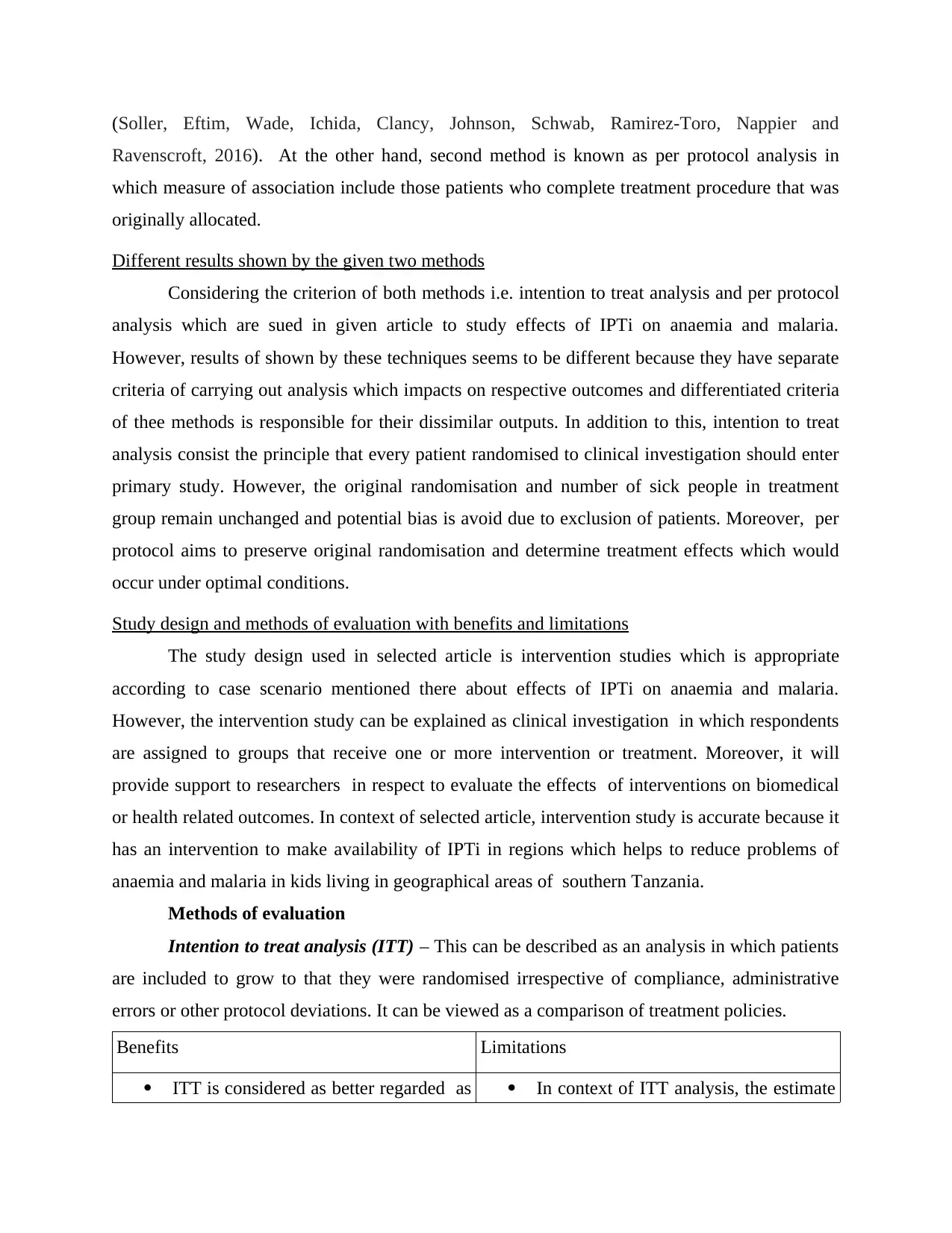
(Soller, Eftim, Wade, Ichida, Clancy, Johnson, Schwab, Ramirez-Toro, Nappier and
Ravenscroft, 2016). At the other hand, second method is known as per protocol analysis in
which measure of association include those patients who complete treatment procedure that was
originally allocated.
Different results shown by the given two methods
Considering the criterion of both methods i.e. intention to treat analysis and per protocol
analysis which are sued in given article to study effects of IPTi on anaemia and malaria.
However, results of shown by these techniques seems to be different because they have separate
criteria of carrying out analysis which impacts on respective outcomes and differentiated criteria
of thee methods is responsible for their dissimilar outputs. In addition to this, intention to treat
analysis consist the principle that every patient randomised to clinical investigation should enter
primary study. However, the original randomisation and number of sick people in treatment
group remain unchanged and potential bias is avoid due to exclusion of patients. Moreover, per
protocol aims to preserve original randomisation and determine treatment effects which would
occur under optimal conditions.
Study design and methods of evaluation with benefits and limitations
The study design used in selected article is intervention studies which is appropriate
according to case scenario mentioned there about effects of IPTi on anaemia and malaria.
However, the intervention study can be explained as clinical investigation in which respondents
are assigned to groups that receive one or more intervention or treatment. Moreover, it will
provide support to researchers in respect to evaluate the effects of interventions on biomedical
or health related outcomes. In context of selected article, intervention study is accurate because it
has an intervention to make availability of IPTi in regions which helps to reduce problems of
anaemia and malaria in kids living in geographical areas of southern Tanzania.
Methods of evaluation
Intention to treat analysis (ITT) – This can be described as an analysis in which patients
are included to grow to that they were randomised irrespective of compliance, administrative
errors or other protocol deviations. It can be viewed as a comparison of treatment policies.
Benefits Limitations
ITT is considered as better regarded as In context of ITT analysis, the estimate
Ravenscroft, 2016). At the other hand, second method is known as per protocol analysis in
which measure of association include those patients who complete treatment procedure that was
originally allocated.
Different results shown by the given two methods
Considering the criterion of both methods i.e. intention to treat analysis and per protocol
analysis which are sued in given article to study effects of IPTi on anaemia and malaria.
However, results of shown by these techniques seems to be different because they have separate
criteria of carrying out analysis which impacts on respective outcomes and differentiated criteria
of thee methods is responsible for their dissimilar outputs. In addition to this, intention to treat
analysis consist the principle that every patient randomised to clinical investigation should enter
primary study. However, the original randomisation and number of sick people in treatment
group remain unchanged and potential bias is avoid due to exclusion of patients. Moreover, per
protocol aims to preserve original randomisation and determine treatment effects which would
occur under optimal conditions.
Study design and methods of evaluation with benefits and limitations
The study design used in selected article is intervention studies which is appropriate
according to case scenario mentioned there about effects of IPTi on anaemia and malaria.
However, the intervention study can be explained as clinical investigation in which respondents
are assigned to groups that receive one or more intervention or treatment. Moreover, it will
provide support to researchers in respect to evaluate the effects of interventions on biomedical
or health related outcomes. In context of selected article, intervention study is accurate because it
has an intervention to make availability of IPTi in regions which helps to reduce problems of
anaemia and malaria in kids living in geographical areas of southern Tanzania.
Methods of evaluation
Intention to treat analysis (ITT) – This can be described as an analysis in which patients
are included to grow to that they were randomised irrespective of compliance, administrative
errors or other protocol deviations. It can be viewed as a comparison of treatment policies.
Benefits Limitations
ITT is considered as better regarded as In context of ITT analysis, the estimate
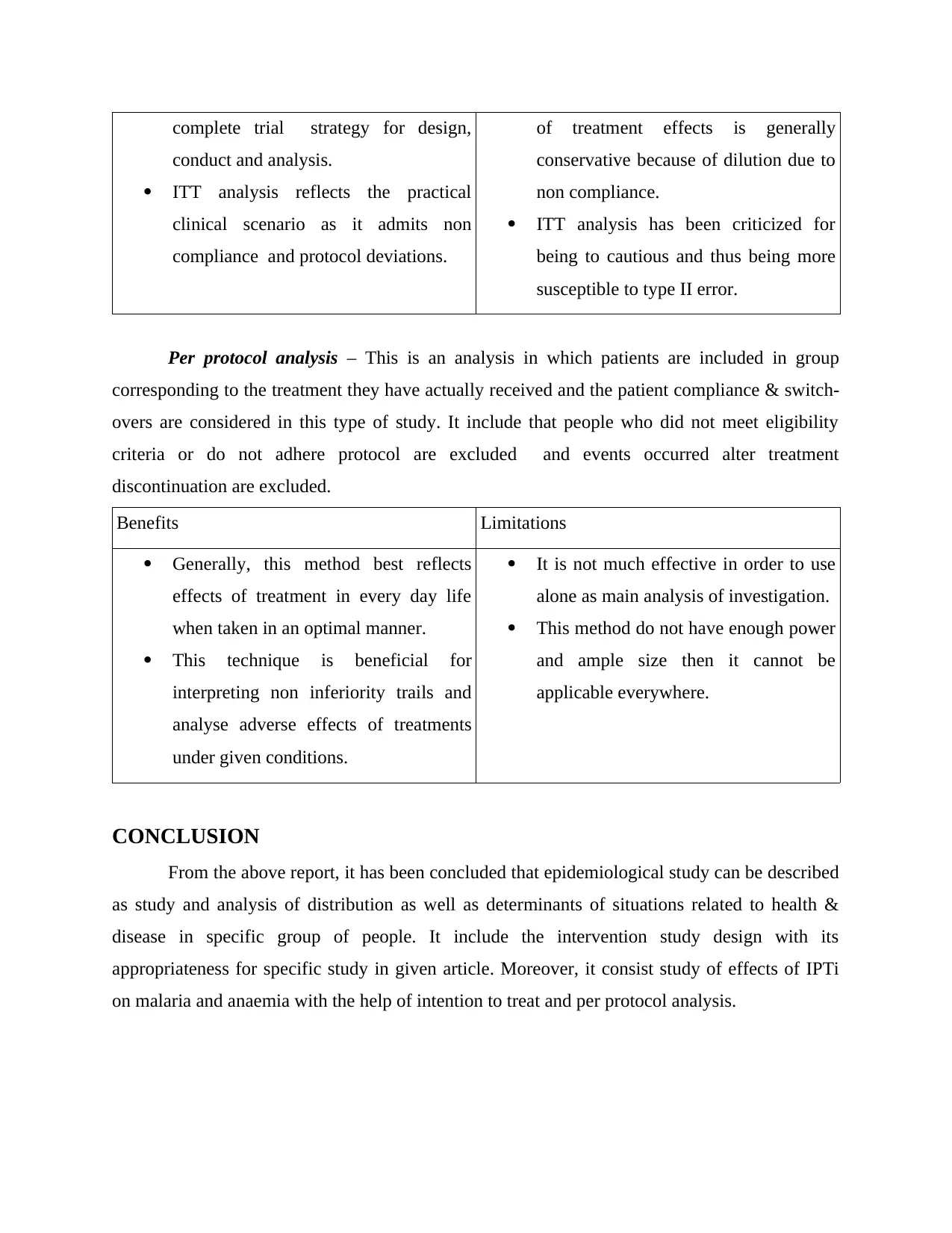
complete trial strategy for design,
conduct and analysis.
ITT analysis reflects the practical
clinical scenario as it admits non
compliance and protocol deviations.
of treatment effects is generally
conservative because of dilution due to
non compliance.
ITT analysis has been criticized for
being to cautious and thus being more
susceptible to type II error.
Per protocol analysis – This is an analysis in which patients are included in group
corresponding to the treatment they have actually received and the patient compliance & switch-
overs are considered in this type of study. It include that people who did not meet eligibility
criteria or do not adhere protocol are excluded and events occurred alter treatment
discontinuation are excluded.
Benefits Limitations
Generally, this method best reflects
effects of treatment in every day life
when taken in an optimal manner.
This technique is beneficial for
interpreting non inferiority trails and
analyse adverse effects of treatments
under given conditions.
It is not much effective in order to use
alone as main analysis of investigation.
This method do not have enough power
and ample size then it cannot be
applicable everywhere.
CONCLUSION
From the above report, it has been concluded that epidemiological study can be described
as study and analysis of distribution as well as determinants of situations related to health &
disease in specific group of people. It include the intervention study design with its
appropriateness for specific study in given article. Moreover, it consist study of effects of IPTi
on malaria and anaemia with the help of intention to treat and per protocol analysis.
conduct and analysis.
ITT analysis reflects the practical
clinical scenario as it admits non
compliance and protocol deviations.
of treatment effects is generally
conservative because of dilution due to
non compliance.
ITT analysis has been criticized for
being to cautious and thus being more
susceptible to type II error.
Per protocol analysis – This is an analysis in which patients are included in group
corresponding to the treatment they have actually received and the patient compliance & switch-
overs are considered in this type of study. It include that people who did not meet eligibility
criteria or do not adhere protocol are excluded and events occurred alter treatment
discontinuation are excluded.
Benefits Limitations
Generally, this method best reflects
effects of treatment in every day life
when taken in an optimal manner.
This technique is beneficial for
interpreting non inferiority trails and
analyse adverse effects of treatments
under given conditions.
It is not much effective in order to use
alone as main analysis of investigation.
This method do not have enough power
and ample size then it cannot be
applicable everywhere.
CONCLUSION
From the above report, it has been concluded that epidemiological study can be described
as study and analysis of distribution as well as determinants of situations related to health &
disease in specific group of people. It include the intervention study design with its
appropriateness for specific study in given article. Moreover, it consist study of effects of IPTi
on malaria and anaemia with the help of intention to treat and per protocol analysis.
⊘ This is a preview!⊘
Do you want full access?
Subscribe today to unlock all pages.

Trusted by 1+ million students worldwide
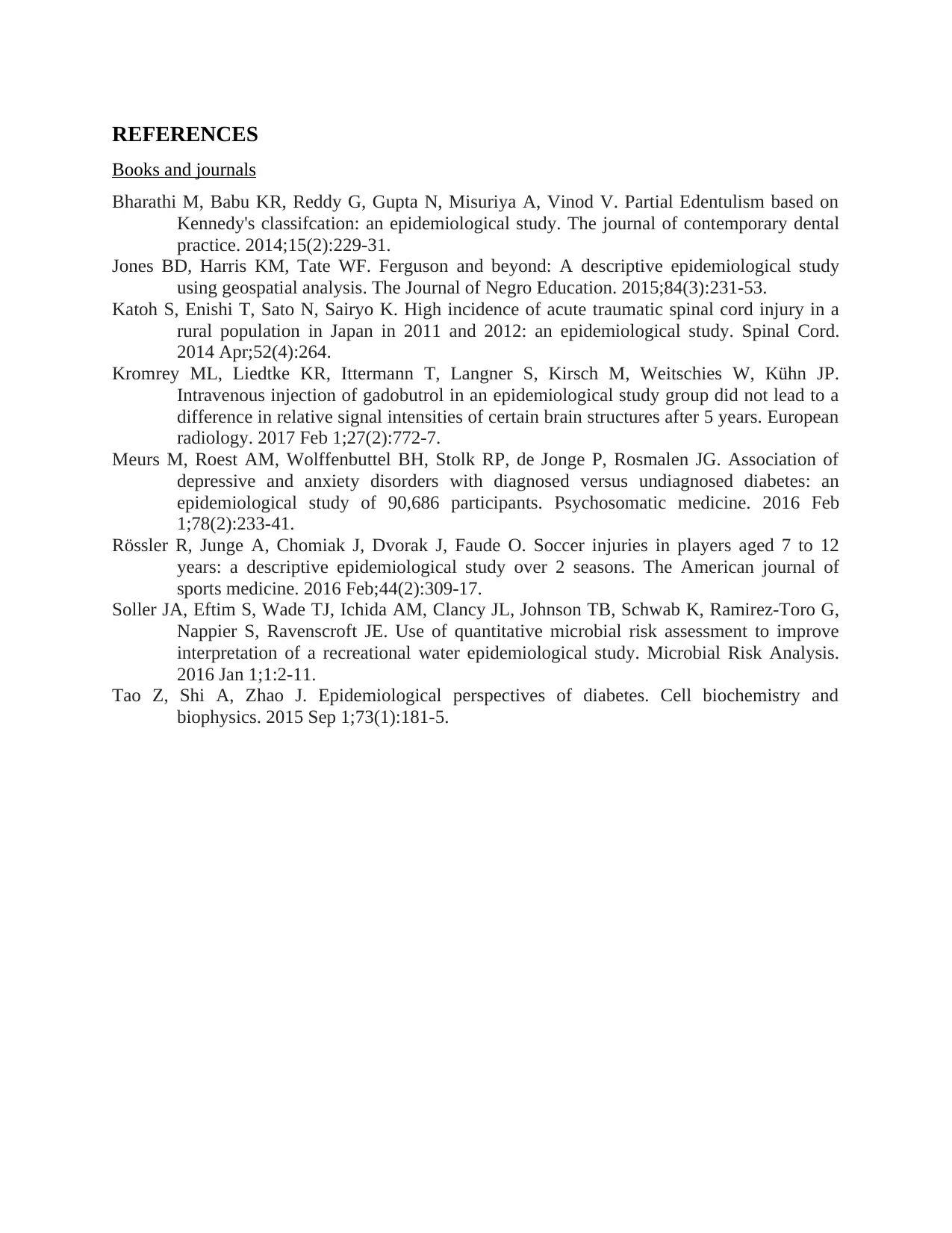
REFERENCES
Books and journals
Bharathi M, Babu KR, Reddy G, Gupta N, Misuriya A, Vinod V. Partial Edentulism based on
Kennedy's classifcation: an epidemiological study. The journal of contemporary dental
practice. 2014;15(2):229-31.
Jones BD, Harris KM, Tate WF. Ferguson and beyond: A descriptive epidemiological study
using geospatial analysis. The Journal of Negro Education. 2015;84(3):231-53.
Katoh S, Enishi T, Sato N, Sairyo K. High incidence of acute traumatic spinal cord injury in a
rural population in Japan in 2011 and 2012: an epidemiological study. Spinal Cord.
2014 Apr;52(4):264.
Kromrey ML, Liedtke KR, Ittermann T, Langner S, Kirsch M, Weitschies W, Kühn JP.
Intravenous injection of gadobutrol in an epidemiological study group did not lead to a
difference in relative signal intensities of certain brain structures after 5 years. European
radiology. 2017 Feb 1;27(2):772-7.
Meurs M, Roest AM, Wolffenbuttel BH, Stolk RP, de Jonge P, Rosmalen JG. Association of
depressive and anxiety disorders with diagnosed versus undiagnosed diabetes: an
epidemiological study of 90,686 participants. Psychosomatic medicine. 2016 Feb
1;78(2):233-41.
Rössler R, Junge A, Chomiak J, Dvorak J, Faude O. Soccer injuries in players aged 7 to 12
years: a descriptive epidemiological study over 2 seasons. The American journal of
sports medicine. 2016 Feb;44(2):309-17.
Soller JA, Eftim S, Wade TJ, Ichida AM, Clancy JL, Johnson TB, Schwab K, Ramirez-Toro G,
Nappier S, Ravenscroft JE. Use of quantitative microbial risk assessment to improve
interpretation of a recreational water epidemiological study. Microbial Risk Analysis.
2016 Jan 1;1:2-11.
Tao Z, Shi A, Zhao J. Epidemiological perspectives of diabetes. Cell biochemistry and
biophysics. 2015 Sep 1;73(1):181-5.
Books and journals
Bharathi M, Babu KR, Reddy G, Gupta N, Misuriya A, Vinod V. Partial Edentulism based on
Kennedy's classifcation: an epidemiological study. The journal of contemporary dental
practice. 2014;15(2):229-31.
Jones BD, Harris KM, Tate WF. Ferguson and beyond: A descriptive epidemiological study
using geospatial analysis. The Journal of Negro Education. 2015;84(3):231-53.
Katoh S, Enishi T, Sato N, Sairyo K. High incidence of acute traumatic spinal cord injury in a
rural population in Japan in 2011 and 2012: an epidemiological study. Spinal Cord.
2014 Apr;52(4):264.
Kromrey ML, Liedtke KR, Ittermann T, Langner S, Kirsch M, Weitschies W, Kühn JP.
Intravenous injection of gadobutrol in an epidemiological study group did not lead to a
difference in relative signal intensities of certain brain structures after 5 years. European
radiology. 2017 Feb 1;27(2):772-7.
Meurs M, Roest AM, Wolffenbuttel BH, Stolk RP, de Jonge P, Rosmalen JG. Association of
depressive and anxiety disorders with diagnosed versus undiagnosed diabetes: an
epidemiological study of 90,686 participants. Psychosomatic medicine. 2016 Feb
1;78(2):233-41.
Rössler R, Junge A, Chomiak J, Dvorak J, Faude O. Soccer injuries in players aged 7 to 12
years: a descriptive epidemiological study over 2 seasons. The American journal of
sports medicine. 2016 Feb;44(2):309-17.
Soller JA, Eftim S, Wade TJ, Ichida AM, Clancy JL, Johnson TB, Schwab K, Ramirez-Toro G,
Nappier S, Ravenscroft JE. Use of quantitative microbial risk assessment to improve
interpretation of a recreational water epidemiological study. Microbial Risk Analysis.
2016 Jan 1;1:2-11.
Tao Z, Shi A, Zhao J. Epidemiological perspectives of diabetes. Cell biochemistry and
biophysics. 2015 Sep 1;73(1):181-5.
1 out of 10
Related Documents
Your All-in-One AI-Powered Toolkit for Academic Success.
+13062052269
info@desklib.com
Available 24*7 on WhatsApp / Email
![[object Object]](/_next/static/media/star-bottom.7253800d.svg)
Unlock your academic potential
Copyright © 2020–2025 A2Z Services. All Rights Reserved. Developed and managed by ZUCOL.




